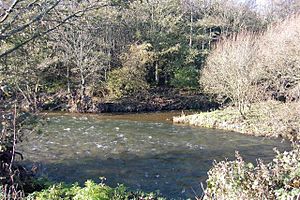River Keekle facts for kids
The River Keekle is a river that flows through the English county of Cumbria. It's a smaller river that eventually joins a larger one.
Contents
About the River Keekle
Where the River Starts
The River Keekle begins at a place called Keekle Head Farm. This farm is located on High Park, between the villages of Gilgarran and Asby.
From its start, the river slowly flows south. It passes through an area that used to be an open cast mine between Frizington and Whitehaven. The river then goes past a small village also named Keekle.
Where the River Ends
The River Keekle continues its journey until it reaches Cleator. At Cleator, the Keekle joins the River Ehen. This means the Keekle's water becomes part of the River Ehen. Sometimes, you can find many salmon in the River Keekle.
The River's Mining History
Old Coal Mines Near the River
For a long time, the area around the River Keekle was important for coal mining. In 1880, a coal mine called Oatlands Pit was dug at Keekle Head. The Moresby Coal Company built this mine. They also built houses for the miners in a nearby place called Pica Village.
The Oatlands Pit was about 500 yards southeast of Pica. A railway line, the Rowrah Branch, helped transport coal from the mine. The mine stopped producing coal in 1930 and closed completely in 1932. It was finally abandoned in 1934.
Open Cast Mining in the Valley
In the 1980s, the Oatlands area became part of a very large open cast coal mining project. This type of mining digs coal from the surface, creating big open pits. The valley of the River Keekle was used for this mining. After the coal was removed, the site was used to bury waste from the mines and other rubbish.
Protecting the River Keekle
Plans for Waste Storage
In 2012, a company wanted to build a special storage site at Keekle Head. This site would hold low-level radioactive waste from nuclear sites. However, the local government, Cumbria County Council, said no to the plan. They believed it would harm the beautiful landscape around the river.
The company appealed this decision, which led to a public meeting. Many groups, like Radiation Free Lakeland, strongly opposed the idea of putting radioactive waste near the river.
Removing the Plastic Liner
In the 1990s, about 2.5 kilometers of the River Keekle's bed was covered with a plastic liner. This was done to protect the river from possible pollution from old mine water. There were also worries that if the riverbed wore away, it could uncover deeply buried mine waste.
Over time, this plastic liner started to break apart. Pieces of plastic washed downstream, causing problems like:
- Blockages in the river.
- Small floods in some areas.
- Plastic pollution in the River Keekle.
This plastic also threatened the River Ehen, which is a very important natural area.
Restoring the River
From 2019 to 2020, a group called the West Cumbria Rivers Trust started a big project. They spent about £1.5 million to remove the old plastic liner. They wanted to bring the riverbed back to its natural state.
They removed about 150 tonnes of plastic. This plastic was then shredded, cleaned, and recycled. To celebrate the project's success, some of the recycled plastic was even used to make a bench and a picnic table at the Walkmill Community Woodland car park.
Now, the River Keekle is slowly returning to its natural condition. You can see natural gravel, stones, and sand building up in the riverbed. This part of the river has the chance to become a wonderful home for wildlife and a great place for people to visit.


